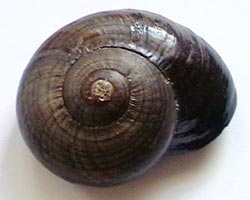- Powelliphanta
Taxobox
name = "Powelliphanta"

image_caption = The shell of a species of "Powelliphanta" land snail.
status = EN
regnum =Animal ia
phylum =Mollusca
classis =Gastropoda
subclassis =Orthogastropoda
superordo =Heterobranchia
ordo =Pulmonata
subordo =Eupulmonata
familia =Rhytididae
genus = "Powelliphanta"
genus_authority = O’Connor, 1945
subdivision_ranks =Species
subdivision = See text."Powelliphanta",
common name amber snails, is a genus of large, carnivorous landsnail s, terrestrialpulmonate gastropod mollusc s. As a group their survival status is endangered.There are 21 species and 51 subspecies within the genus. The relationship between the species is complex, and it has been suggested that the group "Powelliphanta gilliesi-traversi-hochstetteri-rossiana-lignaria-superba" forms a
ring species .In November 2003 a subspecies, thought to be extinct, was rediscovered alive on the West Coast; it had last been documented on the basis of shell fragments in 1934.
Distribution
These large snails are endemic to
New Zealand , in small areas of the North andSouth Island s, with the greatest diversity of species in the mountains of northwest Nelson in the South Island.Habitat
These snails live mostly in tiny pockets of moist native bush.
hell description
These gastropods are large, with shells up to 9 cm across ("Powelliphanta superba prouseorum").
Their striking delicately-patterned shells come in an array of shades, from brown or red to yellow or black. The structure of these shells is very delicate, with a very thin layer of
calcium carbonate , covered by a thickerchitin ous outer layer. These snails need moist surroundings, otherwise the outer layer (periostracum ) dries, shrinks and cracks. This happens often in museum shells of this genus which are stored dry; when they dry too much, the shell shatters explosively into fairly small pieces.Life habits
Species in the genus "Powelliphanta" are
carnivorous and eat mostly earthworms or slugs. They arenocturnal . They need moist surroundings and thus they live buried under leaf mould and logs.They can live for 20 years or more and are slow to mature, reaching sexual maturity around 5 years of age. They are
hermaphrodite s, having both male and female characteristics. They lay 5 to 10 large eggs a year.Fossil record
Their origin goes back 200 million years to the continent
Gondwana . Through their isolation in New Zealand, they have evolved a unique set of characteristics. They are a clear demonstration of New Zealand’s unique biodiversity.Human use
An unspecified species of "Powelliphanta" recently appeared on a New Zealand 40-cent
postage stamp .Conservation status
The IUCN Red List states for "Powelliphanta marchantii" a lower risk, near threatened. But most of these snails are under serious threat or even in danger of extinction. They have no defense against introduced predators, such as
common brushtail possum s, "Trichosurus vulpecula", andrat s. Many recovery plans are being launched by theNew Zealand Department of Conservation . The subspecies "Powelliphanta gilliesi brunnea" and "Powelliphanta traversi otakia" are the most threatened.pecies and subspecies within the genus "Powelliphanta"
* "
Powelliphanta annectens "
* "Powelliphanta fiordlandica "
* "Powelliphanta gilliesi "
** "Powelliphanta gilliesi aurea "
** "Powelliphanta gilliesi brunnea "
** "Powelliphanta gilliesi compta "
** "Powelliphanta gilliesi fallax "
** "Powelliphanta gilliesi gilliesi "
** "Powelliphanta gilliesi kahurangica "
** "Powelliphanta gilliesi jamesoni "
** "Powelliphanta gilliesi montana "
** "Powelliphanta gilliesi subfusca "
* "Powelliphanta hochstetteri "
** "Powelliphanta hochstetteri anatokiensis "
** "Powelliphanta hochstetteri bicolor "
** "Powelliphanta hochstetteri consobrina "
** "Powelliphanta hochstetteri hochstetteri "
** "Powelliphanta hochstetteri obscura "
* "Powelliphanta lignaria "
** "Powelliphanta lignaria johnstoni "
** "Powelliphanta lignaria lignaria "
** "Powelliphanta lignaria lusca "
** "Powelliphanta lignaria oconnori "
** "Powelliphanta lignaria rotella "
** "Powelliphanta lignaria ruforadiata "
** "Powelliphanta lignaria unicolorata "
* "Powelliphanta marchanti "
* "Powelliphanta rossiana "
** "Powelliphanta rossiana fletcheri "
** "Powelliphanta rossiana gagei "
** "Powelliphanta rossiana patrickensis "
** "Powelliphanta rossiana rossiana "
* "Powelliphanta spedeni "
** "Powelliphanta spedeni lateumbilicata "
** "Powelliphanta spedeni spedeni "
* "Powelliphanta superba "
** "Powelliphanta superba harveyi "
** "Powelliphanta superba mouatae "
** "Powelliphanta superba prouseorum "
** "Powelliphanta superba richardsoni "
** "Powelliphanta superba superba "
* "Powelliphanta traversi "
** "Powelliphanta traversi florida "
** "Powelliphanta traversi latizona "
** "Powelliphanta traversi koputaroa "
** "Powelliphanta traversi otakia "
** "Powelliphanta traversi tararuaensis "
** "Powelliphanta traversi traversi "Undescribed species
* "
Powelliphanta "Anatoki Range" "
* "Powelliphanta "Augustus" "
* "Powelliphanta "Baton" "
* "Powelliphanta "Buller" "
* "Powelliphanta "Egmont" "
* "Powelliphanta "Garibaldi" "
* "Powelliphanta "Haast" "
* "Powelliphanta "Kirwans" "
* "Powelliphanta "Lodestone" "
* "Powelliphanta "Matakitaki" "
* "Powelliphanta "Matiri" "
* "Powelliphanta "Maungaharuru" "
* "Powelliphanta "Nelson Lakes" "
* "Powelliphanta "Owen" "
* "Powelliphanta "Parapara" "
* "Powelliphanta "Urewera" "
* "Powelliphanta "vittatus" "Undescribed subspecies
* "
Powelliphanta gilliesi "Haidinger" "
* "Powelliphanta gilliesi "Heaphy" "
* "Powelliphanta rossiana "Fox" "
* "Powelliphanta superba "Gouland Range" "
* "Powelliphanta superba "Gunner River" "References
* [http://www.doc.govt.nz/templates/podcover.aspx?id=33189 Department of Conservation information.]
*
Wikimedia Foundation. 2010.
